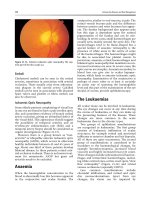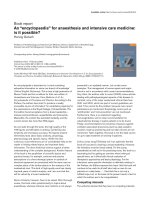Radiology for Anaesthesia and Intensive Care - Part 9 doc
Bạn đang xem bản rút gọn của tài liệu. Xem và tải ngay bản đầy đủ của tài liệu tại đây (941.93 KB, 36 trang )
is contained in a RF screened enclosure. Sensors in this type of equipment
may also be shielded, for example, to prevent the LED cycling in the pulse
oximeter probe from causing further interference.
Main power supplies can carry interference through the RF screen, and
monitoring equipment should use an adequately filtered and isolated
power source or be run by batteries. Batteries are strongly ferromagnetic,
and battery powered monitoring equipment must be very firmly secured
within the magnetic field.
Anaesthesia for MRI
Piped medical gases are essential and the installation of an isolated filtered
AC power circuit and RF filters will minimise interference from monitoring
equipment. Purchase of an MRI-compatible anaesthetic machine and
ventilator, and fibre-optic monitoring systems will reduce potential
problems. MRI-compatible anaesthetic machines with MRI-compatible
ventilators are now made by most of the major manufacturers, these can
be sited adjacent to the magnet bore minimising the length of breathing
systems. Space for resuscitation, induction and recovery from anaesthesia
will enhance patient safety and increase patient throughput.
In my opinion (C.J. Peden) patients are best anaesthetised outside the
magnet room and then transferred into the magnet suite once they are
stable and their airway has been secured. The airway of a patient whose
head goes first into the magnet is completely inaccessible; in addition,
a ‘receiver coil’ is placed around the area being examined which in the case
of a head scan reduces space for tubes and connections. All connections
must be plastic. The laryngeal mask is widely used for MRI, and a mask
with no ferromagnetic components is specifically made for MRI.
Anaesthetists who have not worked in the MRI environment will be
surprised by the level of noise generated during an examination. The
gradient magnetic fields produce a loud thumping or tapping which can be
very disconcerting for the awake patient, and may necessitate deeper levels
of sedation or anaesthesia than might otherwise be required.
Anaesthesia can be maintained with a volatile agent or intravenously.
The motor of infusion pumps may start to malfunction at field strengths of
30–50 G, and extended infusion lines are required.
Intensive care patients
MRI shows much greater detail of the central nervous system than CT.
Therefore, imaging requests for adult and neonatal intensive care patients
with neurological problems are increasing. It is possible to examine these
patients with MRI but it needs planning and plenty of time. The main
problems are caused by the number of lines and infusion pumps attached
to the patient. These should be disconnected unless absolutely essential.
Those infusions that must be continued need extensions of adequate
length to keep the pumps outside the 30-G line.
Another potential problem with sick infants is maintenance of body
temperature as the MR environment is cold and air conditioned to ensure
Anaesthesia in the radiology department
6
268
Chap-06.qxd 09/Oct/02 11:07 AM Page 268
optimal system function. Infants should be returned immediately, at the
end of the examination, to a transport incubator.
Micro-shock
There is a theoretical risk of micro-shock being induced by the passage of
conducting fluid such as 0.9% saline, through central venous or pulmonary
artery catheters in contact with heart muscle in critically ill patients, or
by the induction of current in intravascular pacing wires. This possibility
has been investigated in an animal model and there appears to be little
risk to patients with a central venous catheter. Epicardial pacing wires are
potentially unsafe and should be removed if MRI is essential. There has
been a report of a pulmonary artery catheter with a thermistor wire that
melted during MRI! All patients referred for MRI procedures with
cardiovascular catheters and accessories that have internally or externally
positioned conductive wires or similar components should not undergo
MRI, unless the catheter is removed, due mainly to the risk of excessive
heating in the wires.
Conclusion
Anaesthesia and monitoring in the MRI suite needs to be maintained to
the same standards as expected in the operating theatre. Extra challenges
are produced by the environment of the radiology department and
additionally by the unique nature of the MRI suite.
Patient and staff may be endangered by the missile effect of
ferromagnetic attraction on every-day objects as well as equipment and
surgical implants. Implanted electronic devices may malfunction at very low
magnetic field strength, serious burns may result from currents induced in
monitoring leads and micro-shock may be induced in intravascular or
epicardial devices.
The magnetic, RF and gradient fields may cause artefact and
interference with monitoring devices, especially ECG and pulse oximetry.
These challenges are overcome by meticulous attention to detail,
the design of RF screened MRI suites and the use of commercial monitoring
systems developed specifically for the MRI environment which are both safe
for patients and do not distort or degrade the images produced.
References
1. Recommendations for Standards of Monitoring during Anaesthesia and Recovery.
Association of Anaesthetists of Great Britain and Ireland, 2000.
2. Sedation and Anaesthesia in Radiology. Report of Joint Working Party of the Royal College
of Anaesthetists and the Royal College of Radiologists, 1992.
3. Implementing and Ensuring Safe Sedation Practice for Healthcare Procedures in Adults.
Academy of Medical Royal Colleges, 2001.
4. Intensive Care Society Guidelines for the Transport of the Critically Ill Adult, 2002.
5. C.J. Peden. Monitoring patients during anaesthesia for radiological procedures.
Current Opinions in Anaesthesiology 1999; 12: 405–410.
6. Association of Anaesthetists. Guidelines for the Provision of Anaesthetic Services in Magnetic
Resonance Units, 2002.
MRI: anaesthetic monitoring
6
269
Chap-06.qxd 09/Oct/02 11:07 AM Page 269
MRI: case illustrations
Question 1
55-year-old female.
Long history of unilateral tinitus, deafness, and now ataxia.
Below is a T1-weighted coronal image of the head before and following
IV gadolinium (Figs 6.2 and 6.3).
From where is this lesion arising?
What is the diagnosis?
Anaesthesia in the radiology department
6
270
Fig. 6.2 Quiz case.
Fig. 6.3 Quiz case.
Chap-06.qxd 09/Oct/02 11:07 AM Page 270
Answer
Acoustic neuroma
This lesion appears to arise within the right internal auditory canal (arrow)
and bulges into the cerebellopontine angle. There is compression of
the cerebellum and midline shift to the left. The lesion is very well
circumscribed, and enhances intensely following IV gadolinium.
The appearances are characteristic of an acoustic neuroma, of which
this is a very large example.
Comment
Acoustic neuromas typically have this ‘ice cream cone’ appearance as they
emerge from the internal auditory canal seen well on the axial images
(Figs 6.4 and 6.5), and this appearance helps to differentiate them from
MRI: case illustrations
6
271
Fig. 6.4 Acoustic neuroma axial T2-weighted image. The tumour is of high signal.
Note, the high signal from the CSF identifying it as a T2-weighted image.
Fig. 6.5 Acoustic neuroma axial
post-gadolinium. Note, how the tumour
grows along the internal auditary
meatus – one of the characteristic signs
of acoustic neuroma.
Chap-06.qxd 09/Oct/02 11:07 AM Page 271
meningiomas of the cerebellopontine angle. Acoustic neuromas (85%)
arise from the vestibular portion of the eigth cranial nerve and 15% from
the cochlear division. They may be sporadic, typically occurring in middle
age, or associated with type 2 neurofibromatosis. They are slow growing
but may eventually cause facial sensory loss, weakness, ataxia, long tract
signs and hydrocephalus due to compression of the fourth ventricle.
Anaesthesia in the radiology department
6
272
Chap-06.qxd 09/Oct/02 11:07 AM Page 272
Question 2
MRI: case illustrations
6
273
68-year-old female.
During assessment for a general
anaesthetic she reports
a painful, stiff neck.
On examination, neck
movement is severely restricted
and precipitates pain and
paraesthesia in the right arm.
A lateral cervical spine X-ray and
MRI scan of the neck were
performed.
What are the plain film
(Fig. 6.6) findings?
What additional information
does the MR image (Fig. 6.7)
provide?
Fig. 6.6 Quiz case.
Fig. 6.7 Quiz case.
Chap-06.qxd 09/Oct/02 11:07 AM Page 273
Answer
Degenerative cervical spondylosis with spinal stenosis
The plain film shows reduced intervertebral disc heights from C4 to C7,
there are small anterior osteophytes of the C3 to C7 vertebral bodies
(Fig. 6.6) [arrow 1]. There are large posterior osteophytes at the C5/C6 level
[arrow 2].
The sagittal T2-weighted image (Fig. 6.7) shows narrow dehydrated discs
at multiple levels. There are low signal (black) disc protrusions posteriorly
most marked at the C5/C6 level. These represent bulging degenerate discs,
together with osteophytes from the margins of adjacent vertebral bodies.
There is narrowing of the spinal canal at the C5/C6 level, with
obliteration of the subarachnoid space (containing high signal
cerebrospinal fluid) and impingement upon the spinal cord. This should
also be confirmed with axial images.
Comment
Degenerative disease of the cervical spine can cause stenosis of the nerve
root foramina and, less commonly, the spinal canal (particularly in those
people with a congenitally narrow canal) due to a combination of
several factors (see below). Degenerative disease of the cervical spine or
osteoarthritic changes are referred to as cervical spondylosis.
Changes include:
bulging intervertebral discs,
vertebral end-plate osteophytes,
ligamentum flavum ‘hypertrophy’ (the ligament buckles due to
osteoarthritis of the underlying facet joints).
Spinal canal and nerve root foraminal stenosis is well shown on MRI,
abnormal high signal may be seen within the spinal cord on T2-weighted
images, if there is actual cord compression. Classically, nerve root
compression causes pain, paraesthesiae and lower motor neurone signs in
the upper limbs. Spinal cord compression causes a myelopathy with
additional upper motor neurone signs below the level of impingement,
and sometimes urinary symptoms.
Anaesthesia in the radiology department
6
274
Chap-06.qxd 09/Oct/02 11:07 AM Page 274
Question 3
Answer
Central pontine myelinolysis
There is a large oval-shaped area of high signal within the pons (arrow).
This represents demyelination. This is central pontine myelinolysis. This is a
rare condition in which there is massive demyelination involving the pons
and sometimes the basal ganglia, thalami and internal capsule.
Signs include cranial nerve palsies (particularly the fourth, fifth and sixth),
pyramidal signs in the limbs, bulbar signs and coma.
Associated conditions
Hyponatraemia, which is rapidly corrected.
Chronic alcoholism.
Chronic liver disease.
The prognosis is poor – the 6-month survival rate is approximately 10%
and residual neurological deficits are common. In this case, CPM may have
been avoided by giving 0.9% saline as the initial resuscitation fluid, with
frequent electrolyte analysis, aiming to correct the hyponatraemia by no
more than 10–12 mmol/L in 24 hours.
MRI: case illustrations
6
275
50-year-old male.
7-day history of gastroenteritis.
He was severely dehydrated
and confused.
Plasma sodium ϭ 120 mmol/L.
Hypertonic saline was given to
correct it; 24 hours later, he
developed flaccid weakness in
all four limbs, and difficulty in
swallowing.
Below is a T2-weighted axial
image of the brain (Fig. 6.8).
What is the abnormality?
What conditions are
associated with this
diagnosis?
What is the prognosis?
Fig. 6.8 Quiz case.
Chap-06.qxd 09/Oct/02 11:07 AM Page 275
Question 4
28-year-old pregnant female with hyperemesis gravidarum.
Persistent vomiting and dehydration over the past 36 hours.
Severe headache and now some left-sided weakness.
Shown below are a proton-density weighted axial image of the brain
(Fig. 6.9), and a sagittal MRV image (Fig. 6.10).
What is the diagnosis?
Name some predisposing factors.
Anaesthesia in the radiology department
6
276
Fig. 6.9 Quiz case.
Fig. 6.10 Quiz case (arrows).
Chap-06.qxd 09/Oct/02 11:07 AM Page 276
Answer
Superior sagittal sinus thrombosis
The axial image shows high signal thrombus within the superior sagittal
sinus posteriorly (arrow) (Fig. 6.9), where flowing blood would normally
produce a ‘flow-void’ as in the normal T2-weighted image (Fig. 6.11). The
MRV image shows a lack of signal in the expected position of the superior
sagittal sinus (arrows) (Fig. 6.10). A further case of sinus thrombosis on
MRV (transverse sinus thrombosis) is demonstrated in Fig. 6.12.
MRI: case illustrations
6
277
Fig. 6.11 Normal – flow-void
coming from the sagittal sinus
(arrow).
Fig. 6.12 Transverse sinus
thrombosis MRV.
Chap-06.qxd 09/Oct/02 11:07 AM Page 277
Predisposing factors
Pregnancy.
Oral contraceptive.
Thrombophilia.
Dehydration.
Systemic malignancy, e.g. childhood leukaemia.
Sinusitis and other local sepsis.
Intracranial tumours, e.g. meningioma.
Comment
Intracranial sinus thrombosis may also be diagnosed with contrast
enhanced CT, however, MRI is the investigation of choice when the
diagnosis is suspected. It is sensitive, and non-invasive – in contrast to
conventional cerebral angiography.
Presenting symptoms include headache, seizures, focal neurological
deficits and coma. Sinus thrombosis may lead to venous infarction,
haemorrage and cerebral oedema.
Anaesthesia in the radiology department
6
278
Chap-06.qxd 09/Oct/02 11:07 AM Page 278
Question 5
MRI: case illustrations
6
279
36-year-old intravenous
drug user.
Long history of neck pain,
malaise and low grade fever.
Below is a T2-weighted sagittal
image of the cervical spine
(Fig. 6.13).
What is the cause for this
patient’s symptoms?
What other groups are at
risk of this condition?
Fig. 6.13 Quiz case.
Answer
Discitis with epidural abscess
An area of high signal (white) is seen within the C6/C7 disc space,
representing fluid and inflammatory change. There is destruction of the
end plates of the C6 and C7 vertebral bodies, which are reduced in height.
Some high signal is seen bulging posteriorly (arrow) into the anterior
epidural space – this is an epidural abscess.
Groups at risk of spinal infection
Children – haematogenous spread of infection to a vertebral body or
a vascularised intervertebral disc; usually in the lumbar spine.
Chap-06.qxd 09/Oct/02 11:07 AM Page 279
Adults
Intravenous drug users.
Diabetic.
Immunosupression, e.g. steroids.
Alcoholics.
Genito-urinary infections and instrumentation.
Post-spinal surgery.
Infection starts as a vertebral osteomyelitis which then ‘ruptures’ into
the disc space. May occur at any level, but most commonly lumbar spine.
Comment
Epidural abscess usually occurs as a complication of vertebral osteomyelitis
or discitis, as in this case, and may cause nerve root or spinal cord
compression. Prior to the era of MRI, diagnosis was by the invasive
technique of myelography. Spinal infection may also spread anteriorly,
leading to a retropharyngeal abscess in the cervical region, or psoas abscess
in the lumbar spine (see Fig. 6.14). The condition is a neurosurgical
emergency frequently requiring surgical drainage, decompression and
stabilisation to prevent spinal cord infarction.
Anaesthesia in the radiology department
6
280
Fig. 6.14 Lumbar discitis and psoas
abscess. Coronal STIR image sequence,
this is a fat suppression sequence in
which pathology usually appears high
signal. In this example, the lumbar
intervertebral disc and both adjacent
vertebral bodies are of high signal.
There is an abscess extending into the
right psoas muscle.
Chap-06.qxd 09/Oct/02 11:07 AM Page 280
Question 6
40-year-old male.
Progressive left-sided weakness, visual loss and generalised seizures.
Below are T2-weighted images of the brain (Figs 6.15 and 6.16).
MRI: case illustrations
6
281
Fig. 6.15 Quiz case.
Fig. 6.16 Quiz case.
What is the nature of the this
lesion?
What is the diagnosis?
Chap-06.qxd 09/Oct/02 11:07 AM Page 281
Answer
Arteriovenous malformation
There are multiple areas of serpiginous ‘flow-voids’, predominantly in the
right parieto-occipital region. These are extremely extensive and represent
dilated vessels. There is some associated cerebral atrophy with
compensatory mild dilation of the cerebral ventricles.
Comment
Arteriovenous malformations (AVMs) are congenital lesions, which may be
multiple and can progressively increase in size. Patients may present with
symptoms of a space-occupying lesion such as headache, focal neurological
deficits and epilepsy. AVMs are also a cause of subarachnoid and
intracranial haemorrage. Conventional angiography may still be indicated in
cases where surgery or percutaneous embolisation is being considered,
in order to more clearly define the feeding arteries and draining veins.
Interventional procedures: case illustrations
Anaesthetic support is occasionally required for patients undergoing
interventional procedures in the radiology department; anaesthetic input is
likely to increase as the procedures grow ever complex. The number and
diversity of radiological procedures are increasing with improved imaging
technology and better interventional techniques and devices. There are
vast number of conditions and pathologies which now require
interventional radiology input at either the stage of diagnosis or
treatment.
Most intervention is performed using fluoroscopy, CT or ultrasound
image guidance (ultrasound dealt with in Chapter 7 – Ultrasound and
intensive care). MRI intervention is performed in some centres, but it
accounts for only a small proportion of cases performed. It requires a
specialised open MRI scanner and non-feromagnetic equipment, the high
demand on MRI scanners also limits its use. Anaesthetists require a working
knowledge of common interventional procedures, the common
complications and a working knowledge regarding radiation protection as
both CT and fluoroscopy use ionising radiation.
The following cases serve to illustrate some of the more common
interventional procedures and their potential complications.
Anaesthesia in the radiology department
6
282
Chap-06.qxd 09/Oct/02 11:07 AM Page 282
Question 7
Answer
CT-guided lung biopsy complicated by pneumothorax (Table 6.1)
Prior to lung biopsy, patients should have a platelet count (above 50,000)
and prothrombin time (INR less than 1.3) performed. Antiplatelet drugs
should be discontinued for 7 days prior to the procedure. Resuscitation
equipment should be readily available including chest drain or a pleur-evac
device. Patients should have a venous line in place and are monitored with
an oxygen saturation monitor. Oxygen may be administered during the
procedure – if a pneumothorax develops, oxygen is more rapidly absorbed
than air.
Interventional procedures: case illustrations
6
283
What is this procedure
(Figs 6.17 and 6.18)?
What complication has
occurred?
What are the
contraindications?
What are the potential
complications?
Fig. 6.17 Quiz case.
Fig. 6.18 Quiz case.
Chap-06.qxd 09/Oct/02 11:07 AM Page 283
Patients are positioned supine or prone prior to localising the lesion for
biopsy with CT. Subcutaneous structures are infiltrated with local
anaesthetic (being careful not to transgress the pleura with the local
anaesthetic needle). A fine needle aspiration biopsy (20 or 22 gauge) or
core biopsy can be performed. The needle is advanced to the edge of the
lesion. This may be introduced alone or as part of a coaxial system. Samples
should be performed in arrested respiration. Cytopathology support during
the procedure is preferable. In addition to aspiration samples, some centres
perform core biopsy. The biopsy site should be placed in a dependent
position following the procedure as this promotes atelectasis and reduces
alveolar size – it may help prevent pneumothorax by tamponading the
puncture site.
Using a 20- or 22-gauge needle, sensitivities of up to 90% can be
achieved for thoracic malignancy.
Complications
1. Pneumothorax (see Fig. 6.18): For FNAB, the risk is approximately 5–15%.
Emphysematous changes, multiple pleural punctures, core biopsies and
positive pressure ventilation all increase the risk of pneumothorax.
2. Haemorrhage: Haemoptysis may occur, this is usually self-limiting.
3. Air embolus has been described.
Patients should be monitored (pulse, blood pressure, oxygen saturations for
4 hours) prior to discharge. Many centres perform a chest X-ray to exclude
pneumothorax prior to discharge.
Anaesthesia in the radiology department
6
284
Table 6.1 Contraindications to lung biopsy
1. Patient with single lung (unable to tolerate small pneumothorax).
2. Severe COPD.
3. Mechanical ventilation (increased pneumothorax risk).
4. Bullae in vicinity of lesion to be biopsied.
5. Vascular lesion – AVM.
6. Pulmonary artery hypertension.
7. Bleeding disorder.
Chap-06.qxd 09/Oct/02 11:07 AM Page 284
Question 8
58-year-old patient with a 3-week history of back pain and jaundice.
ERCP was attempted but it was not possible to access the common
bile duct.
What procedure has been performed (Figs 6.19 and 6.20)?
How is this device deployed?
Interventional procedures: case illustrations
6
285
Fig. 6.19 Quiz case.
Fig. 6.20 Quiz case.
Chap-06.qxd 09/Oct/02 11:07 AM Page 285
Answer
Percutaneous transhepatic cholangiogram and biliary stent
A percutaneous transhepatic cholangiogram (PTC) is performed in cases of
biliary obstruction when ERCP is not possible (previous Bilroth II
gastrectomy, choledochojejunostomy) or if ERCP has failed. A fine needle
(22 guage) is used to puncture the biliary tree and inject radiographic
contrast in order to demonstrate the anatomy of the dilated bile ducts.
This initial puncture can be performed under fluoroscopy or using
ultrasound guidance (when a specific duct is targeted). From the
cholangiogram, it is usually possible to confirm the cause of bile duct
obstruction. Common causes included gallstones, cholangio carcinoma,
pancreatic carcinoma, extrinsic compression from liver metastases or benign
strictures, e.g. after bile duct surgery. Metallic stents are inserted only for
malignant bile duct strictures/obstruction.
In order to deploy a metal stent, it is necessary to position a guide wire
across the bile duct stricture and into the duodenum. This is sometimes
done using the initial access for the PTC or it may be performed by
repuncturing the biliary tree at a more suitable site. Once a guide wire is
in the duodenum, the stricture can be dilated with a balloon catheter
(especially if very tight), prior to deploying the stent. The stent delivery
system is passed over the previously sited guide wire and deployed with its
tip just into the duodenum. If a catheter is inserted along the guide wire,
a check cholangiogram can be performed to confirm patency and position
(see Fig. 6.20). The advantage of internal biliary drainage is that it avoids
the electrolyte and fluid losses, and risk of sepsis associated with external
drainage.
Anaesthesia in the radiology department
6
286
Chap-06.qxd 09/Oct/02 11:07 AM Page 286
Question 9
Interventional procedures: case illustrations
6
287
53-year-old man.
Hepatitis C positive for 16 years
following a blood transfusion.
Bleeding oesophageal varices.
What is the therapeutic
intervention that has been
performed (Figs 6.21–6.23)?
What are the indications for
this procedure?
What are the complications?
Fig. 6.21 Quiz case.
Fig. 6.22 Quiz case.
Fig. 6.23 Quiz case.
Chap-06.qxd 09/Oct/02 11:07 AM Page 287
Answer
Transjugular intra-hepatic porto-systemic shunt
Surgical porto-systemic shunts have been created in the past to treat portal
hypertension, e.g. portocaval or splenorenal shunts. A similar result can
now be achieved less invasively using transjugular intra-hepatic
porto-systemic shunt (TIPS). This involves forming an artificial channel
between a hepatic vein and an intrahepatic branch of the portal vein
(Table 6.2).
Procedure
Using a cutaneous approach, a communication tract is created between
a hepatic vein and the portal vein to decompress portal hypertension.
The hepatic veins are catheterised using the right internal jugular vein
for access (via the SVC and right atrium). A passage is created from the
hepatic vein into the portal vein through liver parenchyma. Direct
measurement of the systemic and the portal pressures is then made.
The tract is then dilated with a balloon. A metallic stent is deployed in order
to try and maintain the tract against the recoil of the surrounding liver
parenchyma. The resultant reduction in portal venous pressure can then be
measured. In general, a gradient of less than 12 mmHg is the target. Serial
dilations of the stent can be performed until satisfactory pressure levels
have been reached. Varices can be embolised at this stage (if required)
using a catheter passing through the stent into the portal veins for access.
In patients who may go on to liver transplantation, the stent should occupy
less than half of the extrahepatic portal vein.
Complications of TIPS
Technical failure or incorrect positioning.
Shunt failure/obstruction (resulting in rebleeding from varices).
Encephalopathy.
Hepatic injury.
Anaesthesia in the radiology department
6
288
Table 6.2 Indications for TIPS
Acute variceal haemorrhage
Recurrent variceal haemorrhage
Portal hypertensive gastropathy
Intractable ascites
Hepatic chylothorax
Budd–Chiari syndrome
Chap-06.qxd 09/Oct/02 11:07 AM Page 288
Cirrhosis and portal hypertension
The commonest cause of portal hypertension is cirrhosis secondary to
alcoholic liver disease or chronic hepatitis B or C (see Fig. 6.24), further
causes are listed in Table 6.3. Imaging features of cirrhosis and portal
hypertension include liver nodularity, reversal of portal blood flow
(demonstrated on ultrasound), porto-systemic colateral vessels,
splenomegaly, ascites and complications such as hepatoma. Porto-systemic
colateral vessels occur at many sites (see Table 6.4) as a consequence of
portal hypertension (see Fig. 6.25).
Interventional procedures: case illustrations
6
289
Fig. 6.24 Liver cirrhosis
complicated by hepatoma.
The liver has an irregular, nodular
outline which is typical of cirrhosis.
Hepatomas, such as this example,
have avid arterial enhancement.
Table 6.3 Causes of Portal Hypertension
Prehepatic
Portal vein compression/thrombosis
Hepatic
Cirrhosis (Fig. 6.24)
Hepatic fibrosis congenital/acquired
Cystic fibrosis
Chronic malaria
Schistosomiasis
Post-hepatic
Budd–Chiari syndrome
Constrictive pericarditis
Chap-06.qxd 09/Oct/02 11:07 AM Page 289
Anaesthesia in the radiology department
6
290
Fig. 6.25 Hepatitis C cirrhosis
complicated by portal hypertension.
There is a moderate volume of
ascites and dramatic varices at
the splenic hilum.
Table 6.4 Sites of porto-systemic collaterals
Oesophageal
Coronary vein
Para-umbilical
Abdominal wall
Perisplenic (Fig. 6.25)
Splenorenal
Gastric
Mesenteric
Haemorrhoidal
Chap-06.qxd 09/Oct/02 11:08 AM Page 290
Question 10
What procedure has been carried out?
What are the indications and what are the common complications
(Fig. 6.26)?
Interventional procedures: case illustrations
6
291
Fig. 6.26 Quiz case.
Answer
Oesophageal stent
There is a metallic oesophageal stent which has been inserted in the lower
oesophagus. Malignant oesophageal strictures (whether due to intrinsic or
extrinsic compression) are the main indication (stents are not indicated for
benign disease). Stents are either uncovered, i.e. metal mesh only, or
covered with a plastic membrane over the mesh – covered stents. Covered
stents can be used to treat malignant oesophageal fistulae. Retrosternal
pain can be quite troublesome for few days after stent placement and
Chap-06.qxd 09/Oct/02 11:08 AM Page 291
powerful analgesia is often required. Profound gastro-oesophageal reflux
usually occurs and anti-reflux medication or acid suppression therapy
(proton pump inhibitors, etc.) needs to be prescribed. It is often helpful to
elevate the head of the bed. Bolus obstruction can occur and fizzy drinks
should be taken following meals to help clear any food debris from around
the stent. Tumour ingrowth (particularly with uncovered stents) can be a
problem leading to restenosis or occlusion. Covered stents have a
membrane over the meshwork to help prevent this happening, although
they are more prone to migration. Other complications include
oesophageal perforation and stent migration.
Colo-rectal stenting can also be performed, (see Fig. 6.27). This is useful
in cases of large bowel obstruction as a definitive palliative procedure or as
a temporising measure prior to colonic surgery. The stent decompresses the
large bowel obstruction so that elective surgery is possible after formal
bowel preparation and work-up. The stent is then removed at surgery with
the diseased bowel.
Anaesthesia in the radiology department
6
292
Fig. 6.27 Colo-rectal stent. The initial image shows a narrow irregular stricture
at the junction of the recto-sigmoid colon. The second image is of the metallic stent
once in position.
Chap-06.qxd 09/Oct/02 11:08 AM Page 292









